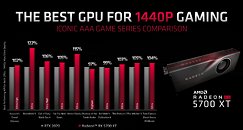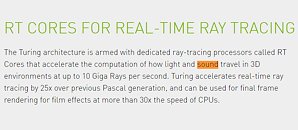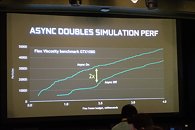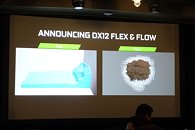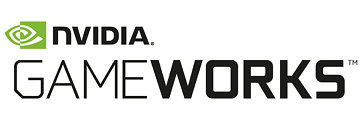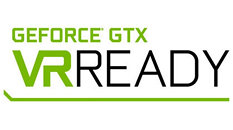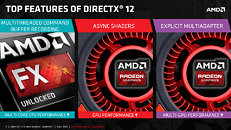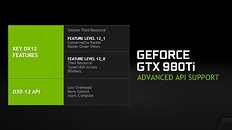Apr 21st, 2025 04:27 EDT
change timezone
Latest GPU Drivers
New Forum Posts
- RX 9000 series GPU Owners Club (432)
- Gainward Phoenix RTX 5070ti Temperatures (9)
- The TPU UK Clubhouse (26155)
- Ryzen Owners Zen Garden (7717)
- What is the best memory for a 285k? (5)
- Extending wifi from a lousy router (35)
- What are you playing? (23406)
- Asus Rx570 o4g cannot losd drivers error code 43 (1)
- [Test Build] Fix for 576.02 Driver Install (31)
- NVCleanstall loading driver versions failed (9)
Popular Reviews
- ASRock X870E Taichi Lite Review
- ASUS GeForce RTX 5060 Ti TUF OC 16 GB Review
- NVIDIA GeForce RTX 5060 Ti PCI-Express x8 Scaling
- Palit GeForce RTX 5060 Ti Infinity 3 16 GB Review
- MSI GeForce RTX 5060 Ti Gaming OC 16 GB Review
- ASUS GeForce RTX 5060 Ti Prime OC 16 GB Review
- Zotac GeForce RTX 5060 Ti AMP 16 GB Review
- MSI GeForce RTX 5060 Ti Gaming Trio OC 16 GB Review
- Teevolution Terra Pro Review
- Sapphire Radeon RX 9070 XT Pulse Review
Controversial News Posts
- NVIDIA GeForce RTX 5060 Ti 16 GB SKU Likely Launching at $499, According to Supply Chain Leak (182)
- NVIDIA Sends MSRP Numbers to Partners: GeForce RTX 5060 Ti 8 GB at $379, RTX 5060 Ti 16 GB at $429 (127)
- NVIDIA Launches GeForce RTX 5060 Series, Beginning with RTX 5060 Ti This Week (112)
- Nintendo Confirms That Switch 2 Joy-Cons Will Not Utilize Hall Effect Stick Technology (105)
- Nintendo Switch 2 Launches June 5 at $449.99 with New Hardware and Games (99)
- Sony Increases the PS5 Pricing in EMEA and ANZ by Around 25 Percent (85)
- NVIDIA PhysX and Flow Made Fully Open-Source (77)
- Windows Notepad Gets Microsoft Copilot Integration (75)
News Posts matching #GameWorks
Return to Keyword Browsing
AMD Radeon RX 5700 XT Beats GeForce RTX 2070 in a Spectrum of Games
The 9.75 TFLOPs figure in the leaked specifications slide of the Radeon RX 5700 XT "Navi" graphics card from earlier today got many guessing if AMD is essentially putting RX Vega-level performance into a GPU that sips a fraction of its power. It turns out that AMD's claim of the RX 5700 XT being faster than the GeForce RTX 2070 wasn't just specific to the odd super-optimized game title, but a whole selection of games, many of which some with GameWorks varnish, some of which even support NVIDIA RTX.
AMD's [leaked] performance slide for the Radeon RX 5700 XT sees the card beat the RTX 2070 in "Assassin's Creed: Odyssey," "Battlefield V," "CoD: Black Ops 4," "Far Cry: New Dawn," "Metro Exodus," Tom Clancy's "The Division 2," "The Witcher 3," and Tom Clancy's "Ghost Recon: Wildlands." The card is also striking distance behind the RTX 2070 at "Shadow of the Tomb Raider," and Sid Meier's "Civilisation 6." All games in this slide are tested at 1440p resolution, with in-game settings maxed out (although we're waiting to read the Endnotes on whether "max out" in NVIDIA's context means turning on RTX on some of these games). The RX 5070 XT beats the RTX 2070 by as much as 22 percent in "Battlefield V," and 15 percent in "Metro Exodus," and is claimed to be within single-digit percentage ahead of the RTX 2070. There's another picture of the RX 5070 XT reference board in this slide, and unless we're mistaken, we spy two 8-pin PCIe power connectors. We'll learn more about this card in a few hours from now.
AMD's [leaked] performance slide for the Radeon RX 5700 XT sees the card beat the RTX 2070 in "Assassin's Creed: Odyssey," "Battlefield V," "CoD: Black Ops 4," "Far Cry: New Dawn," "Metro Exodus," Tom Clancy's "The Division 2," "The Witcher 3," and Tom Clancy's "Ghost Recon: Wildlands." The card is also striking distance behind the RTX 2070 at "Shadow of the Tomb Raider," and Sid Meier's "Civilisation 6." All games in this slide are tested at 1440p resolution, with in-game settings maxed out (although we're waiting to read the Endnotes on whether "max out" in NVIDIA's context means turning on RTX on some of these games). The RX 5070 XT beats the RTX 2070 by as much as 22 percent in "Battlefield V," and 15 percent in "Metro Exodus," and is claimed to be within single-digit percentage ahead of the RTX 2070. There's another picture of the RX 5070 XT reference board in this slide, and unless we're mistaken, we spy two 8-pin PCIe power connectors. We'll learn more about this card in a few hours from now.

Unreal Engine Gets a Host of Real-Time Raytracing Features
Epic Games wants a slice of next-generation NVIDIA GameWorks titles that are bound to leverage the RTX feature-set of its hardware. The latest version of Unreal Engine 4, released as a preview-build, comes with a host of real-time ray-tracing features. In its change-log for Unreal Engine 4.22 Preview, Epic describes its real-time ray-tracing feature to be a "low level layer on top of UE DirectX 12 that provides support for DXR and allows creating and using ray tracing shaders (ray generation shaders, hit shaders, etc) to add ray tracing effects."
The hardware being reference here are the RT cores found in NVIDIA's "Turing RTX" GPUs. At the high-level, Unreal Engine 4 will support close to two dozen features that leverage DXR, including a denoiser for shadows, reflections, and ambient occlusion; rectangular area lights, soft shadows, ray-traced reflections and AO, real-time global illumination, translucency, triangular meshes, and path-tracing. We could see Unreal Engine 4.22 get "stable" towards the end of 2019, to enable DXR-ready games of 2020.
The hardware being reference here are the RT cores found in NVIDIA's "Turing RTX" GPUs. At the high-level, Unreal Engine 4 will support close to two dozen features that leverage DXR, including a denoiser for shadows, reflections, and ambient occlusion; rectangular area lights, soft shadows, ray-traced reflections and AO, real-time global illumination, translucency, triangular meshes, and path-tracing. We could see Unreal Engine 4.22 get "stable" towards the end of 2019, to enable DXR-ready games of 2020.

NVIDIA Does a TrueAudio: RT Cores Also Compute Sound Ray-tracing
Positional audio, like Socialism, follows a cycle of glamorization and investment every few years. Back in 2011-12 when AMD maintained a relatively stronger position in the discrete GPU market, and held GPGPU superiority, it gave a lot of money to GenAudio and Tensilica to co-develop the TrueAudio technology, a GPU-accelerated positional audio DSP, which had a whopping four game title implementations, including and limited to "Thief," "Star Citizen," "Lichdom: Battlemage," and "Murdered: Soul Suspect." The TrueAudio Next DSP which debuted with "Polaris," introduced GPU-accelerated "audio ray-casting" technology, which assumes that audio waves interact differently with different surfaces, much like light; and hence positional audio could be made more realistic. There were a grand total of zero takers for TrueAudio Next. Riding on the presumed success of its RTX technology, NVIDIA wants to develop audio ray-tracing further.
A very curious sentence caught our eye in NVIDIA's micro-site for Turing. The description of RT cores reads that they are specialized components that "accelerate the computation of how light and sound travel in 3D environments at up to 10 Giga Rays per second." This is an ominous sign that NVIDIA is developing a full-blown positional audio programming model that's part of RTX, with an implementation through GameWorks. Such a technology, like TrueAudio Next, could improve positional audio realism by treating sound waves like light and tracing their paths from their origin (think speech from an NPC in a game), to the listener as the sound bounces off the various surfaces in the 3D scene. Real-time ray-tracing(-ish) has captured the entirety of imagination at NVIDIA marketing to the extent that it is allegedly willing to replace "GTX" with "RTX" in its GeForce GPU nomenclature. We don't mean to doomsay emerging technology, but 20 years of development in positional audio has shown that it's better left to game developers to create their own technology that sounds somewhat real; and that initiatives from makers of discrete sound cards (a device on the brink of extinction) and GPUs makers bore no fruit.
A very curious sentence caught our eye in NVIDIA's micro-site for Turing. The description of RT cores reads that they are specialized components that "accelerate the computation of how light and sound travel in 3D environments at up to 10 Giga Rays per second." This is an ominous sign that NVIDIA is developing a full-blown positional audio programming model that's part of RTX, with an implementation through GameWorks. Such a technology, like TrueAudio Next, could improve positional audio realism by treating sound waves like light and tracing their paths from their origin (think speech from an NPC in a game), to the listener as the sound bounces off the various surfaces in the 3D scene. Real-time ray-tracing(-ish) has captured the entirety of imagination at NVIDIA marketing to the extent that it is allegedly willing to replace "GTX" with "RTX" in its GeForce GPU nomenclature. We don't mean to doomsay emerging technology, but 20 years of development in positional audio has shown that it's better left to game developers to create their own technology that sounds somewhat real; and that initiatives from makers of discrete sound cards (a device on the brink of extinction) and GPUs makers bore no fruit.
Final Fantasy XV Windows Edition Release Date, Final System Specs Detailed
The ultimate version of the fifteenth Final Fantasy (how many fantasies can really be final, eh?) has been outed, and now PC gamers now when they can expect to go around the most perfect iteration of the Final Fantasy XV game world. The latest, greatest, and heavily graphically-revised Final Fantasy will finally hit the PC platform on March 6.
The PC version of Final Fantasy XV, will include all previously released DLCs (Episodes Gladiolus, Prompto and Ignis as well as multiplayer), extra bosses, a new dungeon, an in-game vehicle and a first-person mode (this is the one I really have to see). As previously covered, the new PC version has been developed with heavy input from NVIDIA, offers up to 8K resolution in HDR, and includes many NVIDIA GameWorks technologies, such as NVIDIA Flow, NVIDIA HairWorks, NVIDIA Hybrid Frustum Traced Shadows, NVIDIA Turf Effects, NVIDIA Voxel Ambient Occlusion, and more. With all of that NVIDIA technology being built-in, it's somewhat expected that the game will only run the way the developers envisioned on a green team graphics card. Read on after the break for the latest system specs and the Royal Edition release trailer (a special version that's equivalent to the Game of the Year versions of other video-games, with all the released DLC for console players.)
The PC version of Final Fantasy XV, will include all previously released DLCs (Episodes Gladiolus, Prompto and Ignis as well as multiplayer), extra bosses, a new dungeon, an in-game vehicle and a first-person mode (this is the one I really have to see). As previously covered, the new PC version has been developed with heavy input from NVIDIA, offers up to 8K resolution in HDR, and includes many NVIDIA GameWorks technologies, such as NVIDIA Flow, NVIDIA HairWorks, NVIDIA Hybrid Frustum Traced Shadows, NVIDIA Turf Effects, NVIDIA Voxel Ambient Occlusion, and more. With all of that NVIDIA technology being built-in, it's somewhat expected that the game will only run the way the developers envisioned on a green team graphics card. Read on after the break for the latest system specs and the Royal Edition release trailer (a special version that's equivalent to the Game of the Year versions of other video-games, with all the released DLC for console players.)
Final Fantasy XV Windows Edition Coming Early 2018; PC Requirements Listed
Final Fantasy XV has been exceedingly well-received by both critics, consumers, and fans alike, but left out one particular gaming crowd: PC gamers. The original release of November 2016 for XBOX One and PS4 (with PS4 Pro improvements having been baked in the game as well), the game still stands as a showcase for graphics on consoles. However, a true PC, Windows Version of the game is under development in close partnership with NVIDIA, which will see a re-release of the game on PC with many added graphical features, including HDR and 4K resolution support.
Due to its close collaboration with NVIDIA, Final Fantasy XV Windows Edition is expected to be a showcase for NVIDIA GameWorks technologies, such as NVIDIA Flow, NVIDIA HairWorks, NVIDIA Hybrid Frustum Traced Shadows, NVIDIA Turf Effects, NVIDIA Voxel Ambient Occlusion, and more. With all of that NVIDIA technology being built-in, it's somewhat expected that the game will only run the way the developers envisioned on a green team graphics card. However, the system requirements seem to be reasonable - though we expect these to reflect only 1080p gaming, as a 4K presentation fo this game will most likely be a resource hog. As it is, Minimum System Requirements are being listed with DX 11, 8 GB RAM, an Intel Core i5 2400 (3.1GHz) or AMD FX-6100 (3.3GHz) CPU, and GeForce GTX 760 graphics. Recommended System Requirements bring those up: DX 11, 16 GB RAM, Intel Core i7 3770 (3.4GHz) or AMD FX-8350 (4.0GHz) CPU, and GeForce GTX 1060 graphics.
Due to its close collaboration with NVIDIA, Final Fantasy XV Windows Edition is expected to be a showcase for NVIDIA GameWorks technologies, such as NVIDIA Flow, NVIDIA HairWorks, NVIDIA Hybrid Frustum Traced Shadows, NVIDIA Turf Effects, NVIDIA Voxel Ambient Occlusion, and more. With all of that NVIDIA technology being built-in, it's somewhat expected that the game will only run the way the developers envisioned on a green team graphics card. However, the system requirements seem to be reasonable - though we expect these to reflect only 1080p gaming, as a 4K presentation fo this game will most likely be a resource hog. As it is, Minimum System Requirements are being listed with DX 11, 8 GB RAM, an Intel Core i5 2400 (3.1GHz) or AMD FX-6100 (3.3GHz) CPU, and GeForce GTX 760 graphics. Recommended System Requirements bring those up: DX 11, 16 GB RAM, Intel Core i7 3770 (3.4GHz) or AMD FX-8350 (4.0GHz) CPU, and GeForce GTX 1060 graphics.

NVIDIA at Gamescom 2017: ShadowPlay Highlights, Ansel AI Style Transfer and More
Yes, Gamescom 2017 is done already and it would be fair to say that Microsoft took a lot of press time with their Age of Empires IV announcement. This does not mean others were quiet, and indeed we missed what NVIDIA was up to until recently. They held a pre-event show where developers from the most popular games today- PlayerUnknown's Battlegrounds, Destiny 2, Middle Earth: Shadow of War, and Final Fantasy XV Windows Edition- presented new feature trailers (in 4K, of course) supporting NVIDIA's GameWorks technology.
In addition, there were hands-on sessions available with some other upcoming game releases including Pro Evolution Soccer 2018, Forza Motorsport 7, Need for Speed Payback, Project Cars 2 and the recently released Lawbreakers. These games came with some GameWorks announcements as applicable as well.
In addition, there were hands-on sessions available with some other upcoming game releases including Pro Evolution Soccer 2018, Forza Motorsport 7, Need for Speed Payback, Project Cars 2 and the recently released Lawbreakers. These games came with some GameWorks announcements as applicable as well.

NVIDIA Demonstrates GameWorks Flow Tech Under DirectX 12
NVIDIA Flow, was previously announced by the company in 2016's GDC as the new GameWorks implementation for combustible fluid, fire and smoke simulation (superseding NVIDIA's Turbulence and FlameWorks.) It makes use of an adaptive sparse voxel grid for maximum flexibility with the least memory impact, being optimized for use of Volume Tiled Resources when available. With this technology being implemented on the Unreal Engine 4 soon, the company is now looking to increase developer awareness of the tool by showcasing its capabilities.
In the video below, the company is showing off its DirectX 12 implementation of the technology, which showcases gas combustion that results into real-time simulation of fire and smoke in the air.
In the video below, the company is showing off its DirectX 12 implementation of the technology, which showcases gas combustion that results into real-time simulation of fire and smoke in the air.

NVIDIA Announces DX12 Gameworks Support
NVIDIA has announced DX12 support for their proprietary GameWorks SDK, including some new exclusive effects such as "Flex" and "Flow." Most interestingly, NVIDIA is claiming that simulation effects get a massive boost from Async Compute, nearly doubling performance on a GTX 1080 using that style of effects. Obviously, Async Compute is a DX12 exclusive technology. The performance gains in an area where NVIDIA normally is perceived to not do so well are indeed encouraging, even if only in their exclusive ecosystem. Whether GCN powered cards will see similar gains when running GameWorks titles remains to be seen.

NVIDIA Launches GameWorks SDK 3.1
NVIDIA today announced worldwide availability of the NVIDIA GameWorks software development kit (SDK) 3.1, which introduces three groundbreaking graphics techniques for shadows and lighting as well as two new physical simulation algorithms released as betas.
"It's our passion for gaming that drives us to tackle the technical problems presented by real-time rendering and simulation," said Tony Tamasi, senior vice president of content and technology at NVIDIA. "Our GameWorks technologies push the boundaries of what's possible in real time, enabling developers to ship their games with state of the art special effects and simulations."
"It's our passion for gaming that drives us to tackle the technical problems presented by real-time rendering and simulation," said Tony Tamasi, senior vice president of content and technology at NVIDIA. "Our GameWorks technologies push the boundaries of what's possible in real time, enabling developers to ship their games with state of the art special effects and simulations."

NVIDIA Announces Financial Results for the Fourth Quarter and Fiscal 2016
NVIDIA (NASDAQ: NVDA) today reported record revenue for the fourth quarter ended January 31, 2016, of $1.40 billion, up 12 percent from $1.25 billion a year earlier, and up 7 percent from $1.30 billion in the previous quarter. Revenue for fiscal 2016 was a record $5.01 billion, up 7 percent from $4.68 billion a year earlier. GAAP earnings per diluted share for the quarter were $0.35, inclusive of a restructuring charge of $0.04 per diluted share. Non-GAAP earnings per diluted share were $0.52, up 21 percent from $0.43 a year earlier and up 13 percent from $0.46 in the previous quarter.
GAAP earnings per diluted share for the full year were $1.08, inclusive of restructuring charges of $0.15 per diluted share. Non-GAAP earnings per diluted share were $1.67, up 18 percent from $1.42 a year earlier. "We had another record quarter, capping a record year," said Jen-Hsun Huang, co-founder and chief executive officer, NVIDIA. "Our strategy is to create specialized accelerated computing platforms for large growth markets that demand the 10x boost in performance we offer. Each platform leverages our focused investment in building the world's most advanced GPU technology.
GAAP earnings per diluted share for the full year were $1.08, inclusive of restructuring charges of $0.15 per diluted share. Non-GAAP earnings per diluted share were $1.67, up 18 percent from $1.42 a year earlier. "We had another record quarter, capping a record year," said Jen-Hsun Huang, co-founder and chief executive officer, NVIDIA. "Our strategy is to create specialized accelerated computing platforms for large growth markets that demand the 10x boost in performance we offer. Each platform leverages our focused investment in building the world's most advanced GPU technology.

NVIDIA Announces Rise of the Tomb Raider Bundle
The turnaround in developer relations for NVIDIA, propelled by its GameWorks software and a refreshed "The Way It's Meant to be Played" (TWIMTBP) program is best exemplified with the upcoming "Rise of the Tomb Raider." A sequel to the 2013 franchise reboot by Square Enix, which brandished the "AMD Game!" logo, and even bundled with certain AMD Radeon graphics cards; the new Tomb Raider not only features the NVIDIA logo, but will also be bundled with select GeForce graphics cards under the new "Discover the Legend Within" bundle.
NVIDIA is giving away "Rise of the Tomb Raider" with GeForce GTX 980 Ti, GTX 980, and GTX 970 graphics cards. This includes cards sold in the retail channel, as well as gaming desktops that come with those cards pre-installed. On the notebook front, select notebooks running the GTX 980, GTX 980M, and GTX 970M will also give you a key to the game. The bundle extends to participating retailers and OEMs only.
NVIDIA is giving away "Rise of the Tomb Raider" with GeForce GTX 980 Ti, GTX 980, and GTX 970 graphics cards. This includes cards sold in the retail channel, as well as gaming desktops that come with those cards pre-installed. On the notebook front, select notebooks running the GTX 980, GTX 980M, and GTX 970M will also give you a key to the game. The bundle extends to participating retailers and OEMs only.

NVIDIA Announces VR-Ready Certification Program
NVIDIA today unveiled a VR-ready program to help gamers navigate their way to great virtual reality experiences. The company has partnered with PC and notebook makers and add-in card providers to deliver "GeForce GTX VR Ready" systems and graphics cards that deliver an immersive VR gaming experience. The program minimizes confusion regarding which equipment is necessary to play the range of VR games and applications increasingly coming to market.
Delivering a great VR experience demands seven times the graphics processing power of traditional 3D games and applications -- driving framerates above 90 frames per second (fps) for two simultaneous images (one for each eye). "For customers, navigating an emerging technology like VR can be daunting," said Jason Paul, general manager of emerging technologies at NVIDIA. "We're working with trusted partners worldwide to simplify the buying process with a GeForce GTX VR Ready badge that will let customers quickly identify PCs or add-in cards that are capable of handling the demands of VR." NVIDIA GPUs are at the heart of the VR ecosystem and are powered by the award-winning NVIDIA Maxwell graphics architecture, which was created with VR in mind.
Delivering a great VR experience demands seven times the graphics processing power of traditional 3D games and applications -- driving framerates above 90 frames per second (fps) for two simultaneous images (one for each eye). "For customers, navigating an emerging technology like VR can be daunting," said Jason Paul, general manager of emerging technologies at NVIDIA. "We're working with trusted partners worldwide to simplify the buying process with a GeForce GTX VR Ready badge that will let customers quickly identify PCs or add-in cards that are capable of handling the demands of VR." NVIDIA GPUs are at the heart of the VR ecosystem and are powered by the award-winning NVIDIA Maxwell graphics architecture, which was created with VR in mind.

NVIDIA Releases GeForce 361.43 WHQL Drivers
NVIDIA released one of its last GeForce driver releases for the year, version 361.43 WHQL. Surprisingly, these drivers aren't "Game Ready," and as such aren't built around optimization for any new game releases. They instead bring along GameWorks VR 1.1 support, including SLI support for VR applications that use OpenGL. The latest version of Occulus SDK also comes included. The drivers add/update SLI profiles for DayZ, Dungeon Defenders 2, Elite Dangerous (64-bit executable), Hard West (DirectX 11 renderer), and Bless.DOWNLOAD: NVIDIA GeForce 361.43 WHQL

TechPowerUp News: Return of Budget Intel CPU Overclocking and AMD GPUOpen
In this episode of TechPowerUp News: the return of overclocking on budget Intel CPUs by playing with base-clock (BClk); and AMD GPUOpen, the company's ambitious counter to NVIDIA GameWorks that harnesses the power of open-source.

NVIDIA Releases GeForce 358.50 WHQL Game Ready Driver
NVIDIA released the GeForce 358.50 WHQL drivers, which are "Game Ready" for Star Wars: Battlefront Open Beta. Open for pre-loading now on Origin for free, the game goes life in a day. In addition to this, it includes an updated driver support for GameWorks VR SDK; and OpenGL ARB 2015 extensions. This includes support for OpenGL ES 3.2 on the desktop. Grab the driver from the links below.DOWNLOAD: GeForce 358.50 WHQL for Windows 10 64-bit | Windows 10 32-bit | Windows 7/8 64-bit | Windows 7/8 32-bit

Lack of Async Compute on Maxwell Makes AMD GCN Better Prepared for DirectX 12
It turns out that NVIDIA's "Maxwell" architecture has an Achilles' heel after all, which tilts the scales in favor of competing AMD Graphics CoreNext architecture, in being better prepared for DirectX 12. "Maxwell" lacks support for async compute, one of the three highlight features of Direct3D 12, even as the GeForce driver "exposes" the feature's presence to apps. This came to light when game developer Oxide Games alleged that it was pressured by NVIDIA's marketing department to remove certain features in its "Ashes of the Singularity" DirectX 12 benchmark.
Async Compute is a standardized API-level feature added to Direct3D by Microsoft, which allows an app to better exploit the number-crunching resources of a GPU, by breaking down its graphics rendering tasks. Since NVIDIA driver tells apps that "Maxwell" GPUs supports it, Oxide Games simply created its benchmark with async compute support, but when it attempted to use it on Maxwell, it was an "unmitigated disaster." During to course of its developer correspondence with NVIDIA to try and fix this issue, it learned that "Maxwell" doesn't really support async compute at the bare-metal level, and that NVIDIA driver bluffs its support to apps. NVIDIA instead started pressuring Oxide to remove parts of its code that use async compute altogether, it alleges.
Async Compute is a standardized API-level feature added to Direct3D by Microsoft, which allows an app to better exploit the number-crunching resources of a GPU, by breaking down its graphics rendering tasks. Since NVIDIA driver tells apps that "Maxwell" GPUs supports it, Oxide Games simply created its benchmark with async compute support, but when it attempted to use it on Maxwell, it was an "unmitigated disaster." During to course of its developer correspondence with NVIDIA to try and fix this issue, it learned that "Maxwell" doesn't really support async compute at the bare-metal level, and that NVIDIA driver bluffs its support to apps. NVIDIA instead started pressuring Oxide to remove parts of its code that use async compute altogether, it alleges.

NVIDIA Releases the GeForce 355.60 WHQL Game Ready Driver
NVIDIA released its latest version of the GeForce driver software. Version 355.60 WHQL features the "Game Ready" moniker, as it's released just in time for "Ashes of the Singularity," a new RTS in the space-opera setting. Developed by Stardock, this game is one of the first to feature DirectX 12 support. In addition, the drivers include a beta version of NVIDIA's GameWorks VR SDK. Besides optimizations for "Ashes of the Singularity," the drivers add SLI profiles for "Devil May Cry 4: Special Edition," and "Next Car Game: Wreckfest."DOWNLOAD: GeForce 355.60 WHQL for Windows 10 64-bit | Windows 10 32-bit | Windows 8.1/7 64-bit | Windows 8.1/7 32-bit

NVIDIA Bundles Metal Gear Solid V: The Phantom Pain with Select GeForce Products
NVIDIA, which recently withdrew its Batman: Arkham Knight GeForce Bundle following the game's spectacular failure that forced its publishers to pull it off the shelves; announced a new game bundle. The company will be giving away "Metal Gear Solid V: The Phantom Pain" with GeForce GTX 980 Ti, GTX 980, GTX 970, GTX 960, and notebooks with GTX 980M and GTX 970M. There's no info on whether the game got the company's GameWorks varnish (GeForce-exclusive effects), but NVIDIA will give it a proper support package (Game Ready driver with SLI profiles and GeForce Experience settings). As one of the comments to the press-release suggest, it would be nice if the people who fell for the Batman: Arkham Knight bundle could be compensated with keys to this game.

NVIDIA Releases GeForce 353.30 WHQL Game Ready Driver
NVIDIA released its latest "Game Ready" driver that's become customary for the company ahead of a big AAA game launch; GeForce 353.30. These WHQL-signed drivers come "ready" for Batman: Arkham Knight, including SLI profiles, and GeForce Experience settings. The driver also adds an SLI profile for Lord of Vermilion Arena in its DirectX 9 mode. Batman Arkham Knight features NVIDIA's GameWorks varnish, and should feature a few effects and settings exclusive to NVIDIA. The game releases tomorrow (23/06/2015).DOWNLOAD: NVIDIA GeForce 353.30 WHQL for Windows 8/7/Vista 64-bit | Windows 8/7/Vista 32-bit | Windows XP 32-bit | Windows XP 64-bit

NVIDIA Could Capitalize on AMD Graphics CoreNext Not Supporting Direct3D 12_1
AMD's Graphics CoreNext (GCN) architecture does not support Direct3D feature-level 12_1 (DirectX 12.1), according to a ComputerBase.de report. The architecture only supports Direct3D up to feature-level 12_0. Feature-level 12_1 adds three features over 12_0, namely Volume-Tiled Resources, Conservative Rasterization and Rasterizer Ordered Views.
Volume Tiled-resources, is an evolution of tiled-resources (analogous to OpenGL mega-texture), in which the GPU seeks and loads only those portions of a large texture that are relevant to the scene it's rendering, rather than loading the entire texture to the memory. Think of it as a virtual memory system for textures. This greatly reduces video memory usage and bandwidth consumption. Volume tiled-resources is a way of seeking portions of a texture not only along X and Y axes, but adds third dimension. Conservative Rasterization is a means of drawing polygons with additional pixels that make it easier for two polygons to interact with each other in dynamic objects. Raster Ordered Views is a means to optimize raster loads in the order in which they appear in an object. Practical applications include improved shadows.
Volume Tiled-resources, is an evolution of tiled-resources (analogous to OpenGL mega-texture), in which the GPU seeks and loads only those portions of a large texture that are relevant to the scene it's rendering, rather than loading the entire texture to the memory. Think of it as a virtual memory system for textures. This greatly reduces video memory usage and bandwidth consumption. Volume tiled-resources is a way of seeking portions of a texture not only along X and Y axes, but adds third dimension. Conservative Rasterization is a means of drawing polygons with additional pixels that make it easier for two polygons to interact with each other in dynamic objects. Raster Ordered Views is a means to optimize raster loads in the order in which they appear in an object. Practical applications include improved shadows.

NVIDIA Announces "Two Times The Adventure" Game Bundle
NVIDIA announced its latest game bundle for buyers of its GeForce GTX 900 series graphics products. Called "Two Times the Adventure" bundle, it includes two of the year's most anticipated PC titles - "The Witcher 3: Wild Hunt," and "Batman: Arkham Knight." New buyers of GeForce GTX 980 and GTX 970 graphics cards, from participating retailers, will receive game coupons to both the games, which can be redeemed on Steam. New buyers of GeForce GTX 960, and notebooks with GeForce GTX 980M and GTX 970M, will receive game codes to just "The Witcher 3: Wild Hunt."
Codes for both games, if activated on Steam before their launch dates, will count as pre-orders, so you can pre-load and start playing on the launch dates. Both games come with NVIDIA's GameWorks varnish, which enables a few GeForce-exclusive eye-candy, such as HairWorks (GPU-accelerated hair effects) in The Witcher 3, PhysX-accelerated destruction and cloth effects, and HBAO+ in both games. The Witcher 3 releases on May 19, and Batman: Arkham Knight on June 23.
Codes for both games, if activated on Steam before their launch dates, will count as pre-orders, so you can pre-load and start playing on the launch dates. Both games come with NVIDIA's GameWorks varnish, which enables a few GeForce-exclusive eye-candy, such as HairWorks (GPU-accelerated hair effects) in The Witcher 3, PhysX-accelerated destruction and cloth effects, and HBAO+ in both games. The Witcher 3 releases on May 19, and Batman: Arkham Knight on June 23.

NVIDIA Starts Giving Away The Witcher 3: Wild Hunt with Select Products
NVIDIA started giving away game keys to the month's hottest new game release, The Witcher 3: Wild Hunt, with new purchases of select graphics cards. The company is coordinating with its AIC (add-in card) and notebook partners to give away keys that can be redeemed on Steam, with GeForce GTX 960, GeForce GTX 970 and GeForce GTX 980, on the desktop platform; and notebooks with GeForce GTX 970M (and above). The Witcher 3 is built with NVIDIA GameWorks, offering a few GeForce-exclusive features, such as HBAO+, HairWorks, and PhysX.

Ubisoft and NVIDIA Team Up On Assassin's Creed Unity, Far Cry 4 And More
Ubisoft and NVIDIA today announced the next chapter in their strategic partnership bringing amazing PC gaming experiences to life in Ubisoft's highly anticipated upcoming titles including Assassin's Creed Unity, Far Cry 4, The Crew and Tom Clancy's The Division.
NVIDIA's GameWorks Team is working closely with Ubisoft's development studios to incorporate cutting edge graphics technology and gaming innovations to create game worlds that deliver unprecedented realism and immersion. NVIDIA's GameWorks technology includes TXAA antialiasing, which provides Hollywood-levels of smooth animation, soft shadows, HBAO+ (horizon-based ambient occlusion), advanced DX11 tessellation, and NVIDIA PhysX technology.
NVIDIA's GameWorks Team is working closely with Ubisoft's development studios to incorporate cutting edge graphics technology and gaming innovations to create game worlds that deliver unprecedented realism and immersion. NVIDIA's GameWorks technology includes TXAA antialiasing, which provides Hollywood-levels of smooth animation, soft shadows, HBAO+ (horizon-based ambient occlusion), advanced DX11 tessellation, and NVIDIA PhysX technology.
Apr 21st, 2025 04:27 EDT
change timezone
Latest GPU Drivers
New Forum Posts
- RX 9000 series GPU Owners Club (432)
- Gainward Phoenix RTX 5070ti Temperatures (9)
- The TPU UK Clubhouse (26155)
- Ryzen Owners Zen Garden (7717)
- What is the best memory for a 285k? (5)
- Extending wifi from a lousy router (35)
- What are you playing? (23406)
- Asus Rx570 o4g cannot losd drivers error code 43 (1)
- [Test Build] Fix for 576.02 Driver Install (31)
- NVCleanstall loading driver versions failed (9)
Popular Reviews
- ASRock X870E Taichi Lite Review
- ASUS GeForce RTX 5060 Ti TUF OC 16 GB Review
- NVIDIA GeForce RTX 5060 Ti PCI-Express x8 Scaling
- Palit GeForce RTX 5060 Ti Infinity 3 16 GB Review
- MSI GeForce RTX 5060 Ti Gaming OC 16 GB Review
- ASUS GeForce RTX 5060 Ti Prime OC 16 GB Review
- Zotac GeForce RTX 5060 Ti AMP 16 GB Review
- MSI GeForce RTX 5060 Ti Gaming Trio OC 16 GB Review
- Teevolution Terra Pro Review
- Sapphire Radeon RX 9070 XT Pulse Review
Controversial News Posts
- NVIDIA GeForce RTX 5060 Ti 16 GB SKU Likely Launching at $499, According to Supply Chain Leak (182)
- NVIDIA Sends MSRP Numbers to Partners: GeForce RTX 5060 Ti 8 GB at $379, RTX 5060 Ti 16 GB at $429 (127)
- NVIDIA Launches GeForce RTX 5060 Series, Beginning with RTX 5060 Ti This Week (112)
- Nintendo Confirms That Switch 2 Joy-Cons Will Not Utilize Hall Effect Stick Technology (105)
- Nintendo Switch 2 Launches June 5 at $449.99 with New Hardware and Games (99)
- Sony Increases the PS5 Pricing in EMEA and ANZ by Around 25 Percent (85)
- NVIDIA PhysX and Flow Made Fully Open-Source (77)
- Windows Notepad Gets Microsoft Copilot Integration (75)
